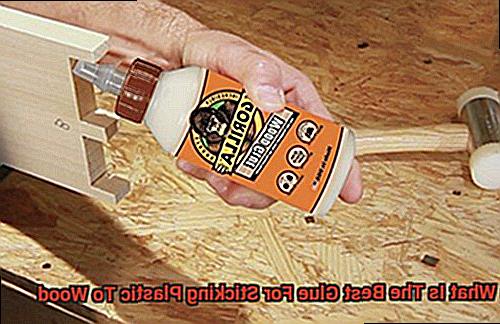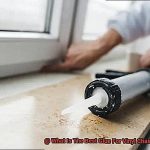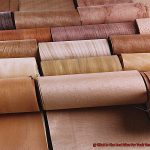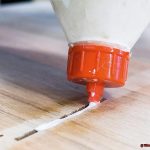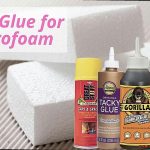Joining plastic and wood can be a real head-scratcher. Whether you’re a DIY enthusiast or a seasoned carpenter, finding an adhesive that does the job right is crucial. But fear not. We’ve got the answer to your sticky conundrum – a glue that defies expectations and forges an unbreakable connection between these two unlikely partners. In this blog post, we proudly unveil the unrivaled adhesive for sticking plastic to wood, showcasing its extraordinary qualities and why it outshines the competition. Bid farewell to feeble bonds and join us as we embark on a journey to discover the glue champ for this specific task.
Factors to Consider When Choosing the Best Glue for Plastic and Wood
Contents
- 1 Factors to Consider When Choosing the Best Glue for Plastic and Wood
- 2 Epoxy Adhesive: An Ideal Option for Bonding Plastic to Wood
- 3 Polyurethane Glue: A Durable and Waterproof Bond
- 4 Super Glue: An Effective Option for Lightweight Plastics
- 5 Special Adhesives for Low Surface Energy Plastics
- 6 Natural Oils and Finishes that Can Affect the Bonding Process
- 7 Preparing Surfaces for Optimal Adhesion
- 8 Conclusion
Finding the right glue for bonding plastic to wood is essential for a strong and long-lasting bond. With numerous options available, selecting the best glue for your project can be overwhelming. In this article, we will explore the essential factors to consider when choosing the perfect glue for plastic and wood.
Compatibility:
Not all glues are equal when it comes to bonding plastic and wood. Choose a glue specifically designed for this purpose, ensuring it explicitly states compatibility with both materials.
Bond Strength:
Consider the strength required for your project. If stress or weight will be placed on the glued surfaces, opt for a glue known for its excellent bond strength, such as epoxy adhesive or polyurethane glue.
Drying Time:
The drying time of the glue is crucial and can impact your project timeline. Some glues dry quickly, while others take longer. Additionally, note how long it takes for the glue to reach its full strength after drying.
Application Method:
Different glues have various application methods, including squeeze bottles, brushes, or sprays. Choose a glue with an application method suitable for your project. Some glues may require mixing or activation before use.
Waterproof and Weather Resistance:
If your project will be exposed to moisture or outdoor elements, select a waterproof and weather-resistant glue to ensure a strong bond even in challenging conditions.
Flexibility:
Flexibility may be important depending on your project’s nature. Certain glues offer flexibility once dried, allowing bonded materials to move or expand without compromising the bond.
Toxicity and Safety:
Consider the toxicity level of the glue and any safety precautions or ventilation requirements during application. Some glues emit fumes or require proper ventilation.
Longevity:
For long-lasting bonds, evaluate the longevity of the glue. Choose a glue that offers a strong and durable bond, ensuring it won’t deteriorate over time.
Ease of Use and Cleanup:
Evaluate the ease of use and cleanup when selecting a glue. Some glues require additional tools or steps, while others are simple to use. Additionally, consider how easy it is to clean up excess glue or spills.
Price:
While cost should not be the sole determining factor, find a balance between quality and affordability. Consider your budget and choose a glue that meets your requirements without breaking the bank.
Epoxy Adhesive: An Ideal Option for Bonding Plastic to Wood
Epoxy adhesive is the ultimate solution for bonding plastic to wood. Its exceptional strength, durability, and resistance to extreme temperatures make it the go-to choice for this specific task. Here’s why epoxy adhesive stands out as the ideal option:
- Unbreakable bond: Epoxy adhesives consist of two mighty components, a resin and a hardener, which, when mixed together, undergo a chemical reaction that forms an unyielding and rigid bond. This means that once cured, the bond created by epoxy adhesive is virtually indestructible and built to withstand heavy loads and harsh environmental conditions.
- Boundless versatility: One of the greatest advantages of epoxy adhesive is its ability to bond different types of plastics, including ABS, PVC, and acrylic, to various types of wood, such as plywood, MDF, and hardwood. This unparalleled versatility makes epoxy adhesive suitable for a wide range of applications.
- Effortless application: Using epoxy adhesive is a breeze. Before application, simply prepare the surfaces by cleaning them with a mild detergent and lightly sanding them to create a rough texture for enhanced adhesion. Then, apply the epoxy evenly on both the plastic and wood surfaces using a brush or spatula. After that, allow the adhesive to cure undisturbed for the specified time. It’s worth noting that epoxy adhesives may take longer to cure compared to other types of adhesives, so exercising patience is crucial.
- Indoor and outdoor reliability: Epoxy adhesives are suitable for both indoor and outdoor applications. Whether you’re assembling furniture or working on a woodworking project that will be exposed to the elements, you can trust epoxy adhesive to provide an unwavering bond that won’t let you down.
- Safety first: Another advantage of epoxy adhesive is its impeccable safety record. It is non-toxic and safe for use on food contact surfaces. So if you prioritize health and safety, epoxy adhesive is the perfect choice for your bonding needs.
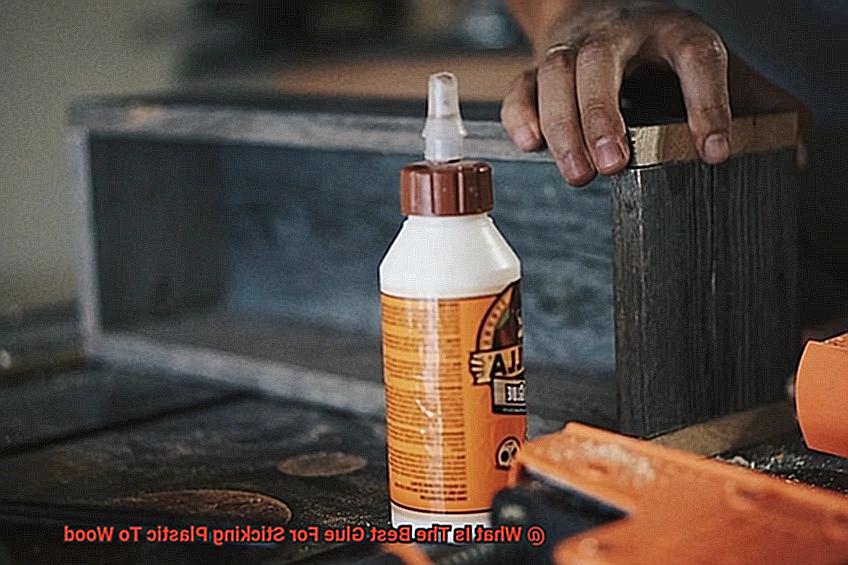
Polyurethane Glue: A Durable and Waterproof Bond
Polyurethane glue is a remarkable adhesive that not only withstands the test of time, but also triumphs over the elements. When it comes to joining plastic and wood, this glue is the ultimate choice, providing a durable and waterproof bond that can conquer any project.
So why is polyurethane glue so extraordinary? Let’s delve into its impressive qualities:
- Versatility: This adhesive is a true multitasker, capable of bonding a wide range of materials, including plastic and wood. Whether you’re a DIY enthusiast or a seasoned professional in the world of woodworking, polyurethane glue has got your back.
- Bonding Power: Sticking plastic to wood can pose a challenge due to the smooth and non-absorbent nature of plastic surfaces. But fear not, polyurethane glue rises to the occasion. It effortlessly penetrates the surface of the plastic, creating a mechanical bond that guarantees a strong and secure connection.
- Waterproof Properties: One of the greatest advantages of polyurethane glue lies in its ability to resist moisture. As we all know, wood tends to expand and contract with changes in humidity levels. However, this glue acts as an impenetrable shield against water damage, ensuring that your bond remains unyielding.
- Unbreakable Strength: Once cured, polyurethane glue becomes exceptionally strong. With its high tensile strength, it can endure stress and strain without succumbing to breakage or detachment from the surfaces it adheres to. Rest assured that your plastic-wood bond will stand strong for years to come.
While polyurethane glue offers an array of benefits, there are some considerations to keep in mind when using it. Due to its expansive nature as it cures, be cautious not to apply excessive amounts, as you may end up with a sticky mess on your hands. Additionally, patience is key as this glue takes longer to dry compared to other adhesives.
Super Glue: An Effective Option for Lightweight Plastics
When it comes to bonding lightweight plastics to wood, you need an adhesive that is fast-acting, durable, and reliable. Look no further than super glue, also known as cyanoacrylate adhesive. This versatile adhesive is a popular choice for DIY enthusiasts and professionals alike.
One of the key reasons why super glue is highly effective is its ability to form a strong bond almost instantly. This is particularly useful for quick repairs or small projects where time is of the essence. Super glue works its magic by creating a chemical reaction upon contact with moisture in the air. As a result, it hardens rapidly, establishing a robust connection between plastic and wood surfaces.
To achieve optimal results, it is crucial to select a super glue formula specifically designed for use on plastics. This ensures that the adhesive will work effectively and deliver a sturdy bond. Before applying the super glue, always ensure that both the plastic and wood surfaces are meticulously cleaned and free of any dirt, dust, or grease. This prepping process guarantees proper adhesion of the adhesive.

When applying the super glue, it is recommended to create a thin and even layer on both surfaces before pressing them firmly together. This technique maximizes the strength of the bond. Allow a few minutes for the surfaces to be held together to permit the super glue to fully bond and cure.
While super glue excels at bonding lightweight plastics like acrylic or PVC, it is not suitable for heavy or load-bearing applications that demand greater strength and durability. In such cases, opting for a stronger adhesive is advisable.
Before committing to using super glue on a large surface area, it is always prudent to conduct a compatibility test by applying it to a small, inconspicuous area first. This ensures desired results without compromising the entire project.
Special Adhesives for Low Surface Energy Plastics
There are special adhesives out there that can solve this sticky situation for you. Let’s dive into the world of glue and explore the various options available.
One popular adhesive for this purpose is cyanoacrylate adhesive, or super glue as it is commonly known. This adhesive is known for its quick bonding properties and ability to create strong bonds between different materials, including plastic and wood. The best part? It works like magic. Just apply a thin layer, press the surfaces together, and watch the bond form in mere minutes. It’s perfect for quick repairs or small projects.
Another option to consider is epoxy adhesive. This adhesive consists of two components – a resin and a hardener – that need to be mixed together before application. Epoxy adhesives provide excellent bonding strength and are resistant to a wide range of environmental conditions. They are particularly useful when dealing with larger or heavier plastic components that require a strong and durable bond.
But what about specific types of low surface energy plastics like polypropylene or polyethylene? Don’t worry. There are specialized adhesives formulated just for them. These adhesives are designed to enhance the bonding strength and durability of the bond between these specific plastics and wood.
Before using any adhesive on low surface energy plastics, it’s important to prepare the surface properly. Clean the plastic surface thoroughly to remove any dirt, oils, or contaminants that may hinder the bonding process. Some adhesives may also require additional surface treatments, such as using a primer or roughening the surface, to improve adhesion.
When selecting the best adhesive for your needs, consider factors such as the type of plastic, desired bond strength, and specific application requirements. Don’t hesitate to consult adhesive manufacturers or experts for guidance.
Natural Oils and Finishes that Can Affect the Bonding Process
Today, we’ll explore the world of natural oils and finishes and how they can affect the bonding process. Get ready for some expert advice on achieving successful bonds in your projects.
The Barrier Effect:
Natural oils and finishes can be sneaky culprits when it comes to bonding plastic to wood. They create a barrier between the two surfaces, hindering the adhesive’s ability to do its job effectively. Linseed oil, for instance, is a popular wood finish that imparts a beautiful sheen but also creates a slick surface that doesn’t play well with glue.
Troublemakers:
Other oils like tung oil, teak oil, and Danish oil are also known troublemakers when it comes to bonding plastic to wood. These protective finishes form a layer that makes it challenging for adhesive to penetrate and form a strong bond. It’s like trying to stick tape on a slippery fish.
Preparation is Key:
To achieve successful bonding, it is crucial to remove any excess oil or finish from the wood surface. Sanding or scraping off these materials will expose raw wood, providing a better surface for adhesive bonding. Consider it as preparing the canvas before painting your masterpiece.
The Right Adhesive:
Using an adhesive specifically designed for bonding plastic to wood can greatly enhance your chances of success. These adhesives act as matchmakers, bringing together unlikely materials in perfect harmony. They have unique properties that allow them to overcome the barriers created by natural oils and finishes.
Surface Preparation:
Remember that thorough cleaning of the plastic surface is essential before bonding. Any dirt or contaminants can hinder the adhesive’s grip. Some adhesives may require additional surface treatments like priming or roughening to ensure a strong bond. Give your project that extra love it deserves.
Preparing Surfaces for Optimal Adhesion
Today, we’re diving into the nitty-gritty of sticking plastic to wood and uncovering the key steps to achieve optimal adhesion. Imagine the frustration of a weak bond that leaves your project falling apart. But fear not. With a little surface prep magic, you’ll be able to create strong and durable bonds that withstand the test of time.
Step 1: Cleanliness is Next to Bond-iness
To ensure a successful bond, start by thoroughly cleaning both the plastic and wood surfaces. Dirt, dust, and grease can act as sneaky barriers, sabotaging the glue’s job. Use a mild detergent or soap and water solution to scrub the surfaces clean. Rinse with water and pat dry with a lint-free cloth. Dry surfaces are essential for achieving optimal adhesion.
Step 2: Sanding for Success
Wood surfaces can be smooth talkers, making it hard for glue to grip tightly. Level the playing field by lightly sanding the wood surface with fine-grit sandpaper. This gentle roughening creates a textured surface that gives the glue something to hold onto. Wipe away any lingering dust with a clean cloth or use compressed air for good measure.
Step 3: Roughening the Plastic
Plastic surfaces can be stubborn adversaries in our quest for optimal adhesion. Their smooth and non-porous nature makes it challenging for glue to stick around. But fear not. We have a secret weapon – sandpaper or a rough sponge. Gently scrub the plastic surface in circular motions, creating tiny scratches or grooves that provide more surface area for the glue to cling onto. Just remember, don’t go overboard and damage the plastic.
Step 4: The Primer Power-Up (optional)
For an extra boost in adhesion, consider using a primer. Primers are like matchmakers, promoting love connections between different materials. Choose a primer designed for both plastic and wood surfaces and follow the manufacturer’s instructions for application and drying time. This extra step can create a stronger bond between our plastic and wood.
Step 5: Test the Waters
Before committing to gluing the actual plastic and wood pieces together, it’s always wise to perform a test bond. Apply a small amount of glue to a sample of both materials and press them firmly together. Allow the bond to cure as per the adhesive manufacturer’s instructions. After the curing period, check the strength and durability of the bond. If it passes with flying colors, you’re ready to move on to the final assembly.
Also Read: What is the best glue to stick fabric to wood?
Conclusion
In conclusion, there are a plethora of adhesive options available for sticking plastic to wood. However, two standout choices for achieving an unbreakable bond are epoxy adhesive and polyurethane glue.
Epoxy adhesive is a true powerhouse when it comes to strength and durability. It forms a bond that can withstand heavy loads and harsh environmental conditions. No matter the type of plastic or wood you’re working with, epoxy adhesive is versatile enough to handle it all. Plus, its indoor/outdoor compatibility means you can trust it in any setting.
If waterproof properties are high on your priority list, then polyurethane glue is the way to go. This glue not only offers durability and versatility but also creates a mechanical bond that laughs in the face of moisture. So whether your project will be exposed to water or outdoor elements, polyurethane glue has got you covered.
For those lightweight plastics that need a quick fix, super glue (cyanoacrylate adhesive) can work wonders. Its fast-acting nature allows for swift bonding, perfect for time-sensitive projects. Just keep in mind that super glue may not be the best choice for heavy-duty applications requiring maximum strength.
Sometimes, low surface energy plastics like polypropylene or polyethylene require special adhesives tailored specifically for them. These specialized adhesives enhance bonding strength and durability when working with these particular materials.
But remember, no matter which adhesive you choose, proper surface preparation is key to optimal adhesion. Take the time to thoroughly clean the surfaces, sand the wood for better grip, roughen up the plastic surface if needed, and don’t forget about primers when necessary – these steps will significantly boost your bond’s strength.
Before diving headfirst into your project, it’s always wise to perform a test bond first. This ensures that your chosen adhesive works effectively on your specific materials and gives you peace of mind moving forward.
So there you have it – a range of adhesive options to stick plastic to wood.

